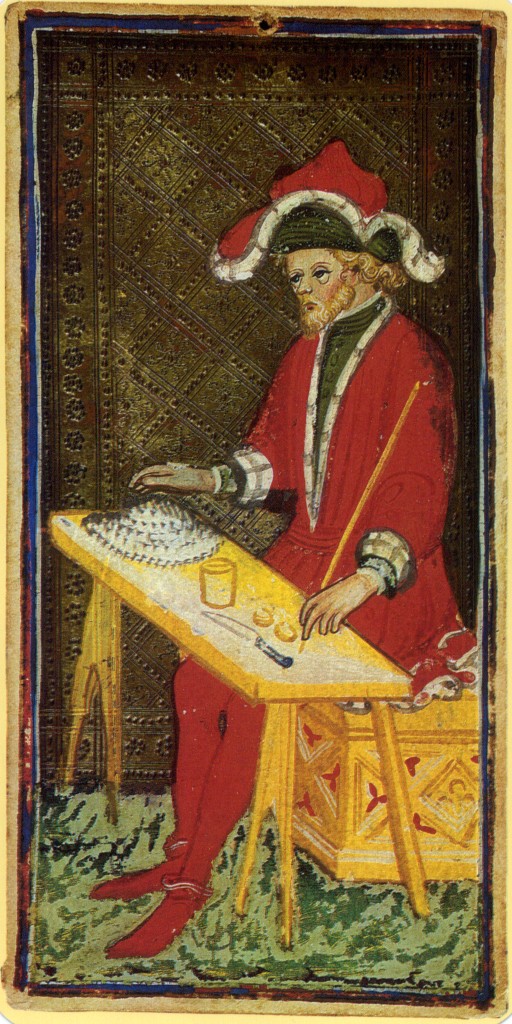|
Page Of Coins
Page of Coins (or jack or knave of coins or pentacles) is a card used in Latin-suited playing cards which include tarot decks. It is part of what tarot card readers call the "Minor Arcana The Minor Arcana, sometimes known as the Lesser Arcana, are the Suit (cards), suit cards in a Cartomancy, cartomantic tarot deck. Ordinary tarot cards first appeared in northern Italy in the 1440s and were designed for tarot card games. They typi ...". Divination usage Often used to represent a young person, in tarot the Jack of Coins can mean a changing of your line of work and/or taking on more responsibility. But primarily, this is the card for students. References Suit of coins {{tarot-stub ... [...More Info...] [...Related Items...] OR: [Wikipedia] [Google] [Baidu] |
Tarot
Tarot (, first known as ''trionfi (cards), trionfi'' and later as ''tarocchi'' or ''tarocks'') is a set of playing cards used in tarot games and in fortune-telling or divination. From at least the mid-15th century, the tarot was used to play trick-taking Tarot card games, card games such as Tarocchini. From their Italy, Italian roots, tarot games spread to most of Europe, evolving into new forms including German Grosstarok and modern examples such as French Tarot and Austrian Königrufen. Tarot is most commonly found in many countries, especially in English and Spanish speaking countries where tarot games are not as widely played, in the form of specially designed Cartomancy, cartomantic decks used primarily for tarot card reading, in which each card corresponds to an assigned archetype or interpretation for divination, fortune-telling or for other non-gaming uses. The emergence of custom decks for use in divination via tarot card reading and cartomancy began after Frenc ... [...More Info...] [...Related Items...] OR: [Wikipedia] [Google] [Baidu] |
Tarot Reading
Tarot card reading is a form of cartomancy whereby practitioners use tarot cards to purportedly gain insight into the past, present or future. The process typically begins with formulation of a question, followed by drawing and interpreting cards to uncover meaning. A traditional tarot deck consists of 78 cards, which can be split into two groups, the Major Arcana and Minor Arcana. French-suited playing cards can also be used; as can any card system with suits assigned to identifiable elements (e.g., air, earth, fire, water). History The first written references to tarot packs occurred between 1440 and 1450 in northern Italy, for example in Milan and Ferrara, when additional cards with allegorical illustrations were added to the common four-suit pack. These new packs were called , triumph packs, and the additional cards were simply known as trionfi, which became "trumps" in English. One of the earliest references to tarot triumphs appears around c. 1450–1470 mentioned by a ... [...More Info...] [...Related Items...] OR: [Wikipedia] [Google] [Baidu] |
Minor Arcana
The Minor Arcana, sometimes known as the Lesser Arcana, are the Suit (cards), suit cards in a Cartomancy, cartomantic tarot deck. Ordinary tarot cards first appeared in northern Italy in the 1440s and were designed for tarot card games. They typically have four suits each of 10 unillustrated pip cards numbered one (ace) to ten, along with 4 Face card, court cards (face cards). Tarot games are still widely played in central and southern Europe; French Tarot is the second most popular card game in France after Belote. By contrast, cartomantic tarot cards emerged in France in the late 18th century, popularised by occultists such as Etteilla. The terms "Major" and "Minor Arcana" originate with Jean-Baptiste Pitois (1811–1877), ''nom de plume'' Paul Christian.Ronald Decker, Thierry Depaulis, and Michael Dummett. ''A Wicked Pack of Cards. The Origins of the Occult Tarot''. New York. St. Martin's Press, 1996 In their contemporary versions, the Minor Arcana are often illustrated— ... [...More Info...] [...Related Items...] OR: [Wikipedia] [Google] [Baidu] |

